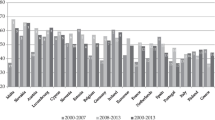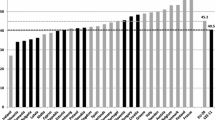Abstract
The objective of this article is to analyse the recent evolution of European neighbouring countries in different dimensions related to economic performance (measured in a broader sense), social progress and institutional reforms. With this aim, we design and build a composite indicator to measure these different dimensions. Next, the index is used to characterise the relative evolution of neighbouring countries compared to a wide sample of developed and developing economies. We also test whether a convergence process has taken place in these different dimensions controlling for the potential effect of the European neighbourhood policy. The obtained results show different trends according to the considered dimensions and heterogeneous effects at the country level. From a policy perspective, these results reinforce the validity of the bilateral action plans that have characterised ENP recognising the different starting point and particular characteristics of each neighbouring country.


Similar content being viewed by others
Notes
Groh and Wich (2012).
As noted by an anonymous referee, equal weighting together with the linear aggregation rule imply that all indicators are perfect substitutes. This means that a decrease of one point in a sub-index can be compensated by a similar increase in another sub-index. The implications of the assumption of compensability have been in-depth analysed by Munda and Nardo (2009).
The correlation of the ISEPI index with GDP per capita for the 76 analysed countries is 0.73, with the Human Development Index 0.82, with the World Economic Forum Global Competitiveness Index is 0.89 (common sample of 75 countries) and with the IMD Competiveness index is 0.84 (common sample of 54 countries).
References
Bartlett W, Cuckovic J, Nojkovic P (2013) Institutional quality and growth in EU neighbouring countries, Search WP 5.11. http://www.ub.edu/searchproject/wp-content/uploads/2013/01/WP-5.11.pdf
Booysen F (2002) An overview and evaluation of composite indices of development. Soc Indic Res 59:115–151
Çolak MS, Ege A (2013) An assessment of EU 2020 strategy: too far to reach? Soc Indic Res 110(2):659–680
Crescenzi R, Luca D, Milio S (2016) The geography of the economic crisis in Europe: national macroeconomic conditions, regional structural factors and short-term economic performance. Camb J Reg Econ Soc 9(1):13–32
Čučković N, Kersimir J, Bartlett W (2015) A comparative perspective on institutional quality in the European neighbourhood. Tijdschrift voor economische en sociale geografie/J Econ Soc Geogr (forthcoming)
Didier T, Hevia C, Schmukler SK (2012) How resilient and countercyclical were emerging economies during the global financial crisis? J Int Money Finance 31(8):2052–2077
Dodini M, Fantini M (2006) The EU neighbourhood policy: implications for economic growth and stability. J Common Mark Stud 44(3):507–532
Dudzińska K (2013) The Baltic states’ success story in combating the economic crisis: consequences for regional cooperation within the EU and with Russia. PISM policy paper 6(54). https://www.pism.pl/files/?id_plik=13084
European Commission (2009) Impact of the global crisis on neighbouring countries of the EU, European economy occasional papers 48. http://ec.europa.eu/economy_finance/publications/publication15398_en.pdf
Fatas A, Mihov I (2009) The 4 I’s of economic growth. INSEAD. http://faculty.insead.edu/fatas/wall/wall.pdf
Garelli S (2014) The fundamentals and history of competitiveness. In: IMD (ed) IMD world competitiveness yearbook. IMD, Lausanne, pp 488–503. ISBN 978-2-9700514-8-0
Giambona F, Vassallo E (2014) Composite indicator of social inclusion for European countries. Soc Indic Res 116(1):269–293
Groh AP, Wich M (2012) Emerging economies’ attraction of foreign direct investment. Emerg Mark Rev 13(2):210–229
Hall JC (2015) Institutional convergence: exit or voice? West Virginia University Department of Economics working paper 15-4. http://www.be.wvu.edu/phd_economics/pdf/15-40.pdf
Harpaz G (2014) Approximation of laws under the European neighbourhood policy: the challenges that lie ahead. Eur Foreign Aff Rev 19(3):429–452
Hlepas N (2015) The quality of the national institutional environment of EU and neighbouring countries in comparative perspective. In: Albarracín J (ed) SEARCH research and assessment on Euro-Mediterranean relations, documents 10 IEMed. European Institute of the Mediterranean, Barcelona, pp 193–230
Lopez-Tamayo J, Royuela V, Suriñach J (2013) Building a “quality in work” index in Spain. In: Joseph SM, Rhonda P, Don R (eds) Community quality-of-life indicators best cases VI. Springer, Berlin, pp 233–262
Liu BC (1978) Variations in social quality of life indicators in medium metropolitan areas. Am J Econ Sociol 37(3):241–260
Mitra S (2013) Towards a multidimensional measure of governance. Soc Indic Res 112(2):477–496
Munda G, Nardo M (2009) Noncompensatory/nonlinear composite indicators for ranking countries: a defensible setting. Appl Econ 41(12):1513–1523
Murillo J, Romaní J, Suriñach J (2015) The Business Excellence Attraction Composite Index (BEACI) in small areas. Design and application to the municipalities of the Barcelona province. Appl Econ 47(2):161–179
Ochel W, Röhn O (2006) Ranking of countries—the WEF, IMD, Fraser and Heritage indices. CESifo DICE Rep 4:48–60
OECD (2008) Handbook on constructing composite indicators. Methodology and user guide. http://www.oecd.org/std/42495745.pdf
PWC (2015) The World in 2050. Will the shift in global economic power continue? https://www.pwc.com/gx/en/issues/the-economy/assets/world-in-2050-february-2015.pdf
Revilla-Diez J, Schiller D, Zvirgzde D (2013) Similarities and differences of institutional change between ENP countries and other catch-up countries. SEARCH WP5.14. http://www.ub.edu/searchproject/wp-content/uploads/2013/01/WP-5.14.pdf
Rodríguez-Pose A, Tselios V (2015) Toward inclusive growth: is there regional convergence in social welfare? Int Reg Sci Rev 38(1):30–60
Royuela V, Suriñach J, Reyes M (2003) Measuring quality of life in small areas over different periods of time. Soc Indic Res 64(1):51–74
Sala-i-Martín X, Bilbao-Osorio B, Blanke J, Drzeniek-Hanouez M, Geiger T, Ko C (2014) The global competitiveness index 2013–2014: sustaining growth building resilience in WEF global competitiveness report 2013–2014, Chapter 1.1, pp 3–52
Savoia A, Sen K (2012) Do we see convergence in institutions? A cross-country analysis, development economics and public policy working paper series WP no. 33/2012. http://www.seed.manchester.ac.uk/medialibrary/IDPM/working_papers/depp/depp_wp33.pdf
Smits J, Steendijk R (2015) The international wealth index (IWI). Soc Indic Res 122(1):65–85
Varga A, Baypinar MB (2016) Economic impact assessment of alternative European Neighborhood Policy (ENP) options with the application of the GMR-Turkey model. Ann Reg Sci 56(1):153–176
Wesselink E, Boschma R (2015) European Neighbourhood Policy: history, structure, and implemented policy measure. Tijdschrift voor economische en sociale geografie/J Econ Soc Geogr (forthcoming)
World Economic Forum (2011) Scenarios for the Mediterranean region. http://www3.weforum.org/docs/WEF_Scenario_MediterraneanRegion_Report_2011.pdf
World Economic Forum (2013) Scenarios for the Russian Federation. http://www3.weforum.org/docs/WEF_Scenarios_RussianFederation_Report_2013.pdf
Wu PC, Fan CW, Pan SC (2014) Does human development index provide rational development rankings? Evidence from efficiency rankings in super efficiency model. Soc Indic Res 116(2):647–658
Acknowledgments
The research leading to these results has received funding from the European Community’s Seventh Framework Programme (FP7/2010-2.2-1) under Grant Agreement No. 266834.
Author information
Authors and Affiliations
Corresponding author
Electronic supplementary material
Below is the link to the electronic supplementary material.
Rights and permissions
About this article
Cite this article
López-Tamayo, J., Ramos, R. & Suriñach i Caralt, J. Economic performance, social progress and institutional reform in European neighbouring countries. Ann Reg Sci 60, 613–636 (2018). https://doi.org/10.1007/s00168-016-0785-2
Received:
Accepted:
Published:
Issue Date:
DOI: https://doi.org/10.1007/s00168-016-0785-2




